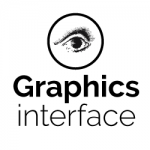The 2011 CHCCS/SCDHM Achievement Award of the Canadian Human Computer Communications Society is presented to Brian Wyvill of the University of Victoria.
Brian Wyvill is Professor and Canada Research Chair in the Department of Computer Science at the University of Victoria. He earned his B.Sc. in 1970 at the University of London and his Ph.D. in 1975 at the University of Bradford, both in the United Kingdom. He took a post-doctoral position at the Royal College of Art in London in the department of Design Research and worked subsequently at a company called System Simulation. In that position he can proudly point to a sequence in the movie Alien that bears his personal touch. He held faculty positions at the University of Calgary from 1981 to 2006 before taking on his present position at the University of Victoria. In these positions, in the last six years alone, he has published over 30 refereed articles. During his career to the present he has supervised 10 PhD students and over 20 MSc students.
The central theme of Brian Wyvill’s research in computer graphics since the mid-1980s has been a search for new concepts and methods that enable a wide variety of users to easily visualize complex models and processes. He has focussed on models and processes that are expressed implicitly rather than explicitly. As a brief summary, an implicit model is one defined by a process that, when given a point, can identify whether or not the point belongs to the model. An explicit model, by contrast, would be defined by a process that generates all the points, and only the points, of the model. Implicit models have certain advantages that make them very appropriate for use in a number of graphical design and visualization applications. Brian Wyvill’s approach is to represent a solid model as the volume inclosed by an iso-surface in a scalar field. The scalar field can be generated in a variety of ways to obtain a large catalog of basic volume elements, and these can then be combined by the use of tools that extend those used in solid modelling. Implicit surfaces have some very attractive properties for modelling, for example gradient and curvature metrics can easily be found, and blending and collision detection are more easily done than with other representations. While some issues remain to be addressed regarding the speed of visualization, the capabilities of interactivity, and the provision of methods for parameterizing implicit surfaces, considerable progress has been made towards easing the adoption of implicit techniques by the modelling community.
Brian Wyvill is recognized as a pioneer of implicit modelling. Many of the algorithms he has developed in his research have had a significant impact on the field. In 1986 for example, together with his brother, Geoff Wyvill, Brian Wyvill developed the first polygonizer for implicit surfaces and iso-surfaces in volume data. Their work incorporated a number of innovative features, such as the use of a hash table to avoid storing every cube, the identification of ambiguous cases, and the use of voxels to avoid considering primitives that do not affect a particular volume. The polygonizer was ground-breaking, seminal and highly influential, and it has been widely cited.
In 1999, Brian Wyvill took the CSG tree, the basic data structure for representing solid-volume models, and developed an extension to this data structure to include implicit models, which he has named the BlobTree. The BlobTree is a tree-structured set of nodes wherein the leaves are implicit primitives and the higher nodes are operations. Recently the set of possible operations has been enlarged to include a wide range of BlobTree nodes, such as blend, warp, animation, bounded blend, precise contact modelling and many others. This provides many tools for shape control that all use the implicit metaphor. The result is a consistent, homogeneous system in which evaluation of objects is done by traversing the tree to find a field value for a particular point in space. Moreover the BlobTree provides a test bed for trying out ideas in implicit modelling and provides basic support for many projects. Future research directions are based on new, faster visualization techniques coupled with innovative and intuitive ways of interactively creating implicit fields. Implicitization methods using radial basis functions enable a real object to be scanned to become a BlobTree primitive. By combining modelling techniques with existing objects, the possibility exists of finding better ways to build complex objects. The BlobTree has become a common way of organizing data for implicit modellers
Brian Wyvill’s 1986 algorithm for the polygonization of implicit models is well known in industry, both for surface representation as well as the visualization of iso-surfaces from volume data. The potential function introduced in 1986 is often called the “Wyvill function” in the modelling community. Visualizing implicit surfaces requires a search through space to find the surface; techniques pioneered by Brian Wyvill’s research have greatly improved the search speed to the point where implicit surface techniques are now a viable alternative to traditional methods. Work with Kees van Overveld in the early-1990’s led to a new polygonization technique that combined CSG and implicit modelling, and for the first time, offered a method for overcoming artifacts in a mesh approximation.
One of the main thrusts of Brian Wyvill’s recent research has been on developing interactive techniques for building implicit models by sketch-based methods. This has included work on a technique for hierarchical spatial caching to speed tree traversal, a method for interactively generating implicit sweep surfaces, and a sketch based modeller itself, called ShapeShop. A disadvantage of implicit modelling compared to parametric modelling for use in games and the animation industry is the difficulty of applying textures. Brian Wyvill and his collaborators offered a solution in 2006 via an interactive technique called decal compositing. Recent work with sketching has led to a new method for applying free form deformation to implicit models. And working with collaborators in France, Brian Wyvill has contributed to a breakthrough in offering solutions to three well known problems of implicit modelling: blending at distance, unexpected blending, and lack of fine detail.
Along the way, during Brian Wyvill’s research career, he has published in areas as varied as interactive modelling, sketch-based systems, illumination and rendering, animation, texturing, hierarchical and subdivision methods, biological and medical models, and physical simulation. Brian Wyvill has promoted the implicit modelling field through journal and conference papers; he has started two conference series and given many invited international lectures and seminars. Other fields of modelling, such as the Level Set research community, owe much to the methods developed by the implicit modelling community based on his algorithms.
No coverage of Brian Wyvill’s activities would be complete without mentioning that he is a stage actor of considerable experience with a resume that includes 14 roles, and counting, together with 6 plays directed, and counting, and 4 plays written, and counting. Add to this a novel just completed. Add further to this an avocation of mountaineering and rock climbing. To his credit in this activity can be counted three routes up El Capitan as well as a number of first ascents, including a route on Cerro Torre in Patagonia and several long routes in the Rockies.





